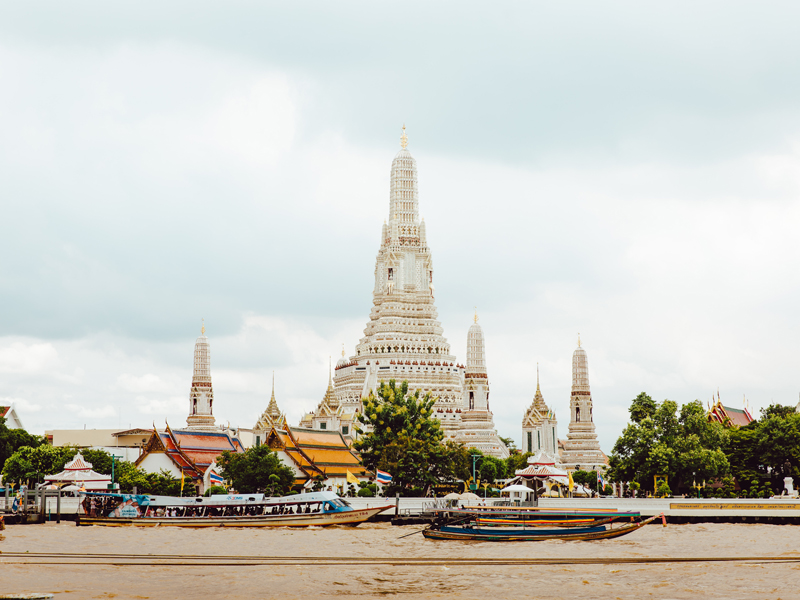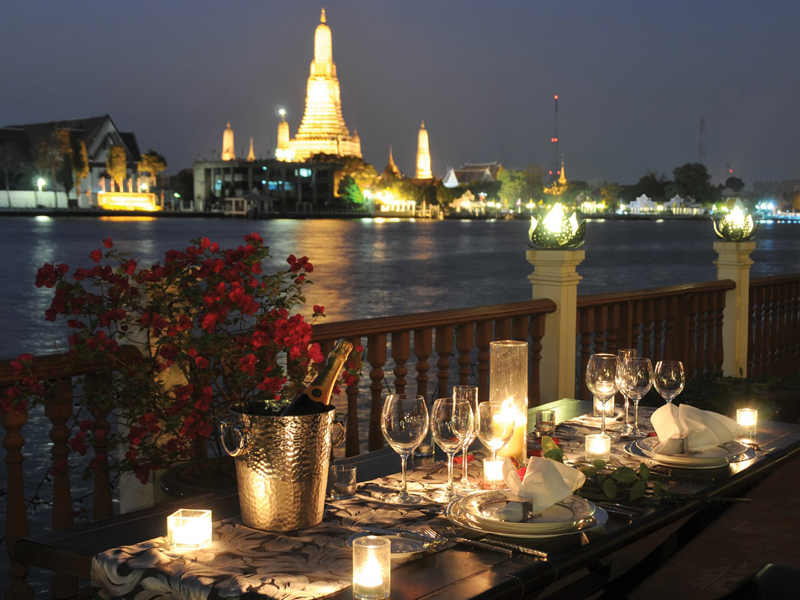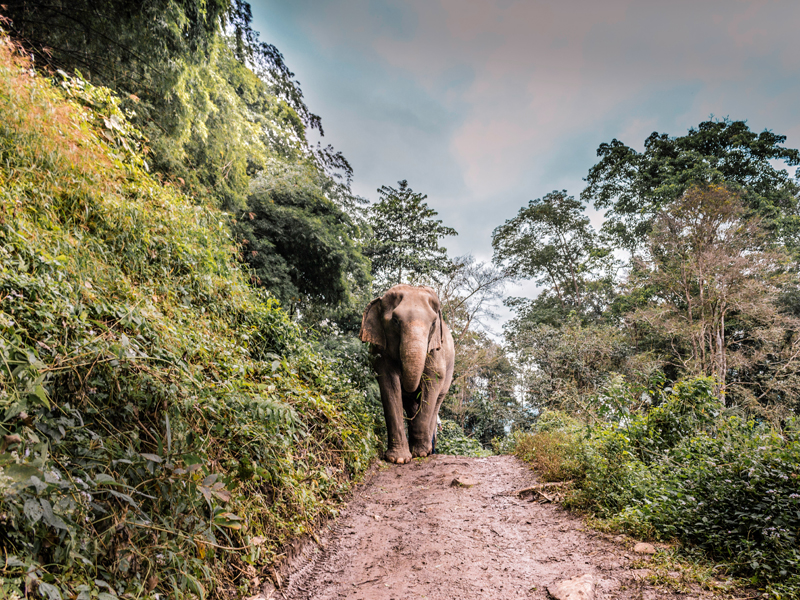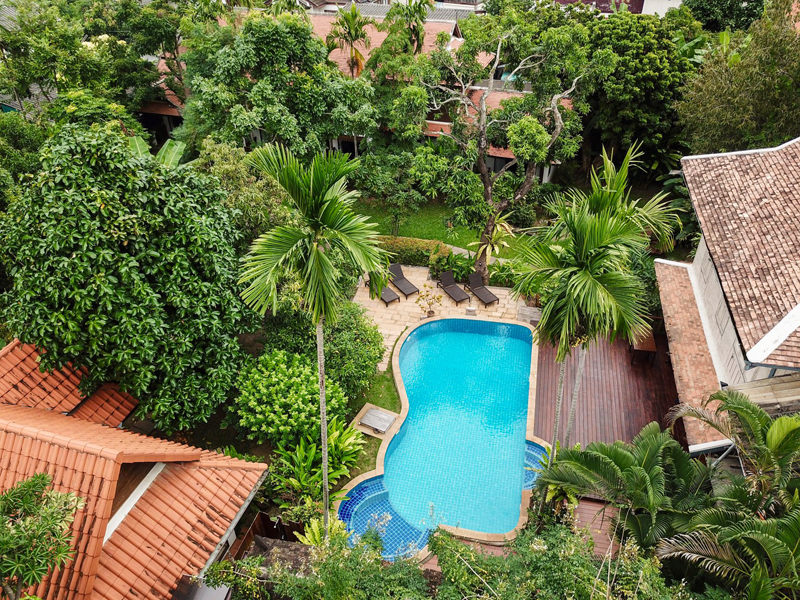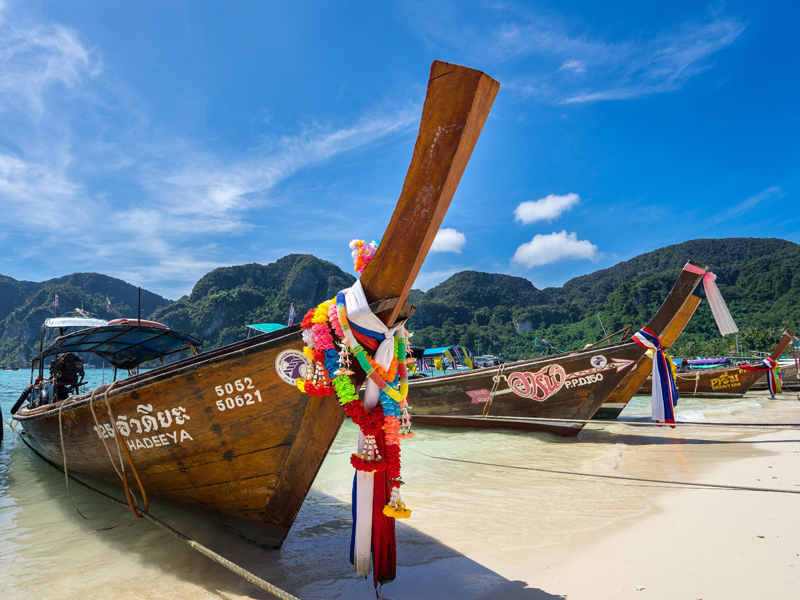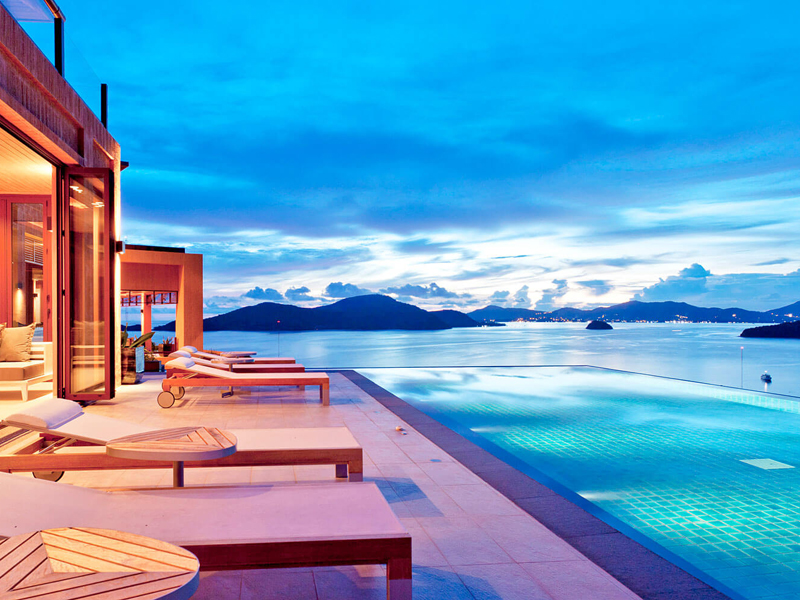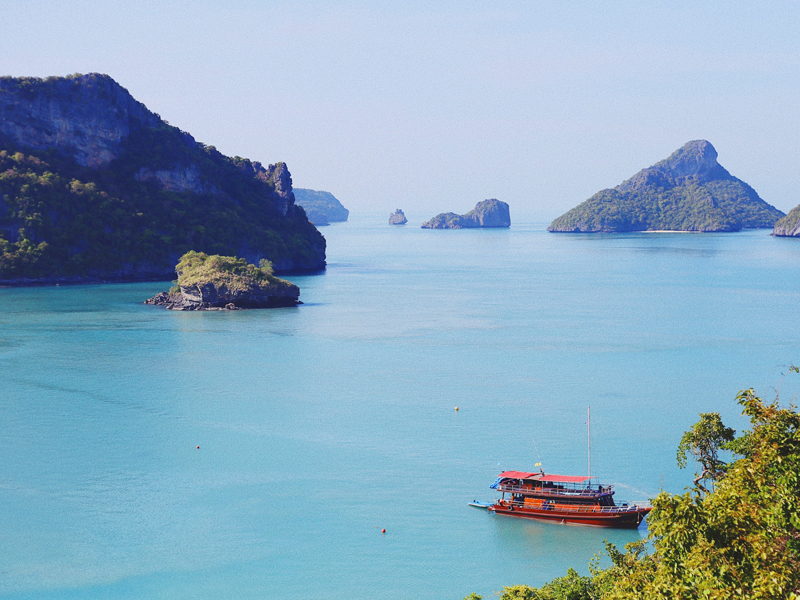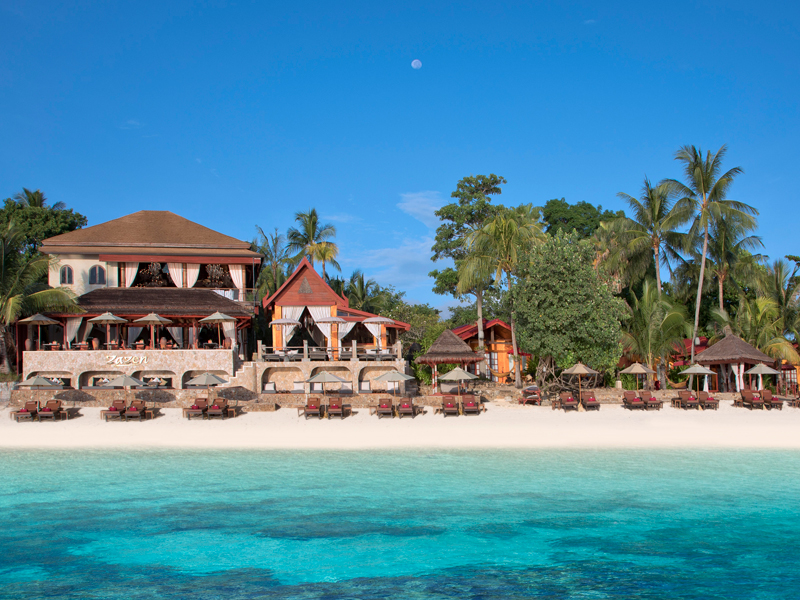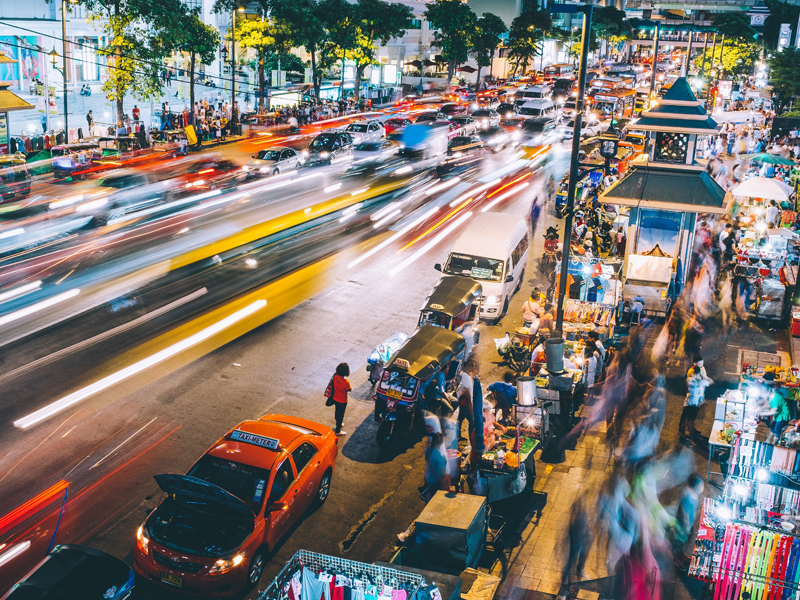
By Marta Purwin, Bookings Consultant
It can be hard to know where to begin when planning a trip to Thailand. A mountainous interior overflowing with cultural splendour sits in stark contrast to Bangkok’s polarising intensity. Plus, there are hundreds of islands to explore, and two monsoon seasons to contend with.
Visit in our winter (Dec-Feb) and you’ll be able to pack in much of the diversity, all without getting wet. Here’s where to go, and when.
JUMP TO: BANGKOK | CHIANG MAI & NORTH | PHUKET & WEST | KOH SAMUI & EAST
Bangkok
Traditional Thai culture meets a modern consumerist capital in Bangkok. Beyond shopping malls and skyscrapers, it’s easy to get lost in the winding canals, markets and temples of a city bridging the gap between two very different ways of life.
Best for…
History & architecture
Overflowing with stunning temples and pagoda complexes, it’s easy to explore Bangkok on foot and take in the unique Buddhist architecture. The Temple of the Reclining Buddha (Wat Pho) and the Temple of Dawn (Wat Arun) are among the most visited sites. A day trip to the ancient capital Ayutthaya is well worth it.
Shopping & street food
There are several different floating markets in and around Bangkok. Damnoen Saduak is the most popular but Amphawa is more authentic, with visitors being more exclusively Thai. This is a great destination to experience genuine Thai seafood, shop for local crafts, or just find a restaurant to watch the hubbub float by. Don’t miss out on a longtail boat ride to bring you even closer to the action.
When to go: December to February
Although hot and humid year-round, Bangkok is best explored from December to February. Temperatures only drop below 20 degrees at night, and daytime temperatures peak in the low 30s, making navigating the city on foot more manageable than during the hotter months of March-June.
In November you risk catching the end of the rainy season (which usually runs from July to October). But crowds are fewer and you can benefit from lower room rates and flight prices.
How to get there
Bangkok has a well-served international airport, allowing easy onward travel to some of Thailand’s more far-flung regions. If you’re flying from Europe you will end up passing through Bangkok even if you aren’t taking extra days out to explore the city.
Direct flights normally start from around £450 with the likes of Thai Airways or British Airways, and take around 12 hours.
Where to stay
Chakrabongse Villas, Bangkok
Our review: “In the heart of the city, with skyscraping condos, aquatic shanty towns and traffic-clogged avenues stretching for miles in every direction, lie Chakrabongse Villas. Leafy gardens, tall palms, colourful frangipanis, raised wooden decks and a flower-ringed swimming pool usher you into a distant dream world. But the view from the floating pavilion is pure Bangkok. Across the Chao Phraya’s busy waters, Wat Arun (the Temple of Dawn) and Wat Kalayanamit flank, like exotic spaceships, the fortress of Vichai Prasit.”
Shanghai Mansion, Bangkok
Our review: “Shanghai Mansion Bangkok is superbly sited for those who wish to stay in the heart of Bangkok’s jubilantly chaotic Chinatown, and who appreciate quirky interior design. Rising above a restaurant and coffee shop (don’t be put off by the mall-like exterior), you reach the second-floor lobby by lift. Architect Julian Coombs has sought to reflect the colour and character of Shanghai Mansion’s namesake. Think decorative Chinese lanterns, plush red silk cushions and antique birdcages.”
Chiang Mai and Northern Thailand
The city of Chiang Mai offers the perfect base camp for exploring Thailand’s mountainous north. Previously the seat of the Lanna Kingdom, the northern provinces are perfect for getting active or just recharging after the bustle of Bangkok.
Best for…
Great outdoors
Doi Inthanon is Thailand’s highest mountain, offering incredible hiking and access to the Kew Mae Pan wildlife trail. It’s a short trip from Chiang Mai and you can combine it with a visit to the Mae-Klang waterfall and Brijinda Cave.
Elephants
Although elephant experiences are one of Thailand’s quintessential tourist attractions, unethical practices and poor living conditions mean it’s often hard to tell whether you are supporting a genuine conservation project. The Elephant Nature Park is close to Chiang Mai and allows you to interact ethically with 35 elephants while helping the charity rescue more animals from tourism and logging industries.
When to go: November to February
This is the ideal time to visit Chiang Mai and the northern province, with visitor numbers peaking in January. Weather is cooler, perfect for hiking and outdoor pursuits, and there are a number of festivals to experience. In November the magical Loy Krathong festival sees hundreds of lanterns released into the skies and candles floated along the rivers. In February you can experience Chiang Mai’s famous flower festival. Avoid travelling too late into spring, as temperatures reach over 40 degrees by the end of March.
How to get there
Depending on your budget and itinerary, there are numerous travel options available:
By train
Sleeper trains allow you to soak up the stunning views, but be aware that some journeys can take over 12 hours. And make sure you are booking the right carriage type – it’s worth upgrading to first-class if you want all the mod cons. Prices vary between class, but you’re likely to pay around £20 one way.
By bus
Buses are the cheapest option, and although often faster than the train, they lack the same level of comfort. There are also additional theft risks to consider, so I would only recommend if you are on a very tight budget.
By air
The fastest way to get to Chiang Mai and Thailand’s northern regions is to fly. A return to Bangkok costs around £50. This is probably my recommended option, especially if you are travelling soon after the rainy season. During this time, flooding and landslides can cause damage to roads. With regular direct flights from Phuket and other parts of Thailand, there is no reason to layover in Bangkok each time you travel.
Where to stay
Baan Orapin Heritage B&B, Chiang Mai
Our review: “A collection of bungalows around a restful, landscaped tropical garden. Baan Orapin takes its name from the century-old teakwood family home at its centre. The owners still live here, and have striven to offer their guests comfort at a reasonable price. All the amenities are in place, floors are teak or hardwood, and furniture is handcrafted. If the surfaces aren’t always finished to the highest of standards, this is compensated doubly by the attentive service and care which manager Khun Opas takes to make you feel welcome. You can ask him anything, and he will provide the answer, map at the ready.”
Tamarind Village, Chiang Mai
Our review: “Tamarind Village is a welcoming, affordable oasis amidst the temples, bazaars, food stalls and night markets of Chiang Mai. Built around a 200-year-old tamarind tree, and approached through a long bamboo tunnel, this collection of buildings with verdant courtyards – inspired by rural temple cloisters – is a gem of a hotel. Bedrooms in boutique Lanna style make the best use of the limited space. There’s a large swimming pool, an unbeatable breakfast buffet, and friendly staff who welcome you with cold drinks and city maps. It’s owned by people who understand the hotel business, so everything runs smoothly, and there’s the usual array of good (if slightly overpriced) spa treatments and tours.”
Phuket and West Coast
I would be lying if I didn’t say that the beaches were my first draw to Thailand. Classic James Bond islands, tropical luxury set against crystal clear waters, and white sand beaches will probably dominate your Instagram posts. Phuket itself is a thriving tourist town with all the nightlife that goes with it, but the real draw is its proximity to the Andaman Coast and the islands of Phang-Nga Bay.
Best for…
Beaches
A term often used when referring to Thailand is that there is an ‘island for everyone’. From Full Moon parties to private bays, there’s a beach to suit all trips. Ao Sane has three mini-beaches, each framed with hulking granite boulders, and can be delightfully quiet during weekends. Or try a 17-minute drive through lush forest to discover Siray beach, a secret still seemingly only known by locals.
Water activities
If you somehow get bored of lounging beachside, you can enjoy the water from a speedboat, kayak or jet ski. There are numerous boat trips which take in the iconic beaches of Krabi, Rang Yai or Phi Phi. Plus, there are more exclusive excursions. Feeling more adventurous? Explore sea caves by kayak or learn to dive with leatherback turtles.
When to go: November to February
With sea and air temperatures averaging 29 degrees, November to February allows you to enjoy the hundreds of miles of beaches without the risk of monsoon rains. February is usually the driest month while December can be cooler. Temperatures peak in March, and humidity levels begin to pick up towards the end of the month.
How to get there
Phuket’s airport is well-connected, with return flights to other internal airports including Chiang Mai starting from £40 return. Unlike Chiang Mai, there are no direct trains from Bangkok and coaches can take over 13 hours, so I would certainly recommend flying.
Phuket is a great base to explore the Andaman Coast, or as an onward stepping stone to Krabi and the islands of Phang-Nga Bay. Once you arrive in Phuket a speedboat or ferry is your best bet to get to other islands. There are multiple services every day. You can travel to Krabi and some of the other mainland destinations by private vans. This can be a hassle-free way to stop along the way, but it does mean you miss out on a mini cruise!
Where to stay
Sri panwa, Phuket
Our review: “Rainforest shades the long, private road to Sri panwa. So, when you finally walk through the unassuming hilltop entrance to this gorgeous hotel, it’ll take your breath away. Wide white steps lead you down to a glass pavilion, moated by a purple water-lily pond. The view is suddenly open and wide, sun-filled and sparkling. Islets hunker around the turquoise bay and longtail boats carve slow furrows in the perfect blue sea, 40m below.”
Baba Ecolodge, Koh Phra Thong
Our review: “Baba Ecolodge is the perfect antidote to the high-density tourism and rampant development found on nearby islands like Phuket and Krabi. With 15 kilometres of empty golden beaches and not a jet ski in sight, the island, although large, is totally undeveloped. When you arrive no buildings are visible. Take an early morning walk along the beach, or swim in a sea turned golden by the sunset, and the place is all yours. Go canoeing along a tidal river or snorkelling in the bath-warm lagoon. You’ll have just hornbills, sea eagles and – if you’re lucky – sea turtles for company.”
Koh Samui and East Coast
Koh Samui, Koh Pha Ngan and the islands of the East Coast are the original backpackers’ territory, so there is evidence of sprawling development, western supermarkets and English-style pubs; but the good news is that none of the island buildings are – by law – taller than a palm tree, and the white-sand beaches are as beautiful as ever. Koh Samui and Koh Pha Ngan are big enough to provide pockets where you can hide from the crowds, with plenty of secluded coves and waterfalls to discover, while the smaller island of Koh Tao is far quieter so you’ll get even closer to nature.
Best for…
Beaches
On Koh Samui, Chaweng has beautiful, enclosed turquoise waters. A fringing reef keeps the sea calm and warm, and the sand is silky-smooth, but it is a popular place so don’t expect to have the beach to yourself. If you’re looking for a quieter beach, try Phang Ka at the southwestern tip of the island. On Koh Pha Ngan, my favourite beaches are Chaloklum in the north, a traditional jungle-backed fishing village with little to do other than sunbathe and swim; Mae Haad in the northwest, where the sea is as flat as a sheet and ideal for snorkelling; and sheltered Than Sadet in the northeast, which is backed by jungle waterfalls.
Full Moon parties
These aren’t everyone’s thing, and you may well wish to avoid them altogether, but if you want a taste of the party life, Koh Pha Ngan is your island. This is the home of the original Full Moon Party. Once a month in the southerly village of Haad Rin, 5,000 to 10,000 people gather to watch the yellow moon rise over the horizon, and then lose themselves in dance, drink and drugs. But do bear in mind that drugs are illegal in Thailand.
When to go: January to March
The East Coast has a later monsoon season than the rest of the country (Oct-Dec), so it can be more of a challenge to combine it with a visit to Thailand’s other regions. January to June sees the driest weather and the most sun, with the earlier months of the year enjoying the most pleasant temperatures.
How to get there
There’s an airport on Koh Samui with regular direct flights to/from Bangkok. The flight time is around 60 minutes, and prices start from around £100 per person. It’s also possible to take a boat from Don Sak or Surat Thani on the mainland (1-2 / 2-4 hours respectively). From Koh Samui, there are ferry services to Koh Pha Ngan and Koh Tao (1-2 / 2-4 hours respectively).
Where to stay
Zazen Boutique Resort & Spa, Koh Samui
Our review: “Zazen Resort is a mecca for rest and romance, with 26 stylish bungalows scattered through exotic gardens and coconut groves. There’s a spa with a very long treatment list, a romantic restaurant serving Thai fusion cuisine, and you can idle away the days supping cocktails on the sand. Active types can go diving and snorkelling, swing through the rainforest canopy or sail out into the blue for deep-sea fishing. So if you’re wound up, wiped out or in need of something wonderful, treat yourself to a week here.”
Narivana, Koh Pha Ngan
Our review: “Perched on a hillside among coconut groves and secondary-growth forest, Narivana is a self-catering property (sleeps 2-8) offering peace and privacy surrounded by nature. Coucals call; dragonflies buzz; flocks of herons make for the hills in autumn. Koh Pha Ngan may be famed for its hedonistic Full Moon parties, but this place is a world away from all that. It consists of four mini villas, with one bedroom and bathroom apiece, and a shared main house with a kitchen, dining and sitting room. Just book as many mini villas as your party requires and you get full run of the property without paying a surcharge for empty rooms, so it’s great value.”
So, what are you waiting for?
Maybe you’ll be searching for the ultimate relaxing beach break or are obsessed with Thailand’s architecture. Perhaps you’re simply looking for an authentic taste of Thai street food. Whatever your adventure, there has never been a better time to book.
